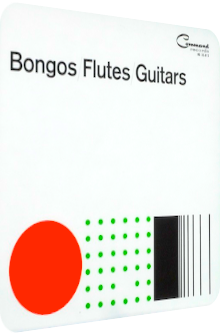
Los Admiradores
Bongos, Flutes, Guitars
1960
Bongos, Flutes, Guitars is the second and last album of the nonet and supergroup Los Admiradores, recorded in New York and released in 1960 on audiophile Enoch Light’s label Command Records. Being the successor to the all too simple-titled Bongos (1959), the band presents another collection of 12 tracks, most of them deriving from the Golden Book of Jazz Standards which is not overly keen on the genre or lifestyle called Exotica. No worries, for Los Admiradores alter the material and either make it superdreamy or delightfully vivid, whatever suits their fancy. Naturally, the tendency as exuded by this record is that it offers more of the same, as the old adage goes. Indeed, its predecessor Bongos has always had the most curious title.
Bongos were on board alright, they appeared on each and every song, but so were guitars, flutes and pianos. Now with Bongos, Flutes, Guitars, supervisor Enoch Light adjusts the title, makes it more precise… and quite a bit uninspiring, though the material lives up to the Exotica lover’s hunting scheme, I’m sure. The principal players are pianist Moe Wechsler, guitarist Tony Mottola, mallet instrumentalist Artie Marotti, flutist and saxophonist Stanley Webb, trumpeter Doc Severinsen, saxophonist Bernie Kaufman as well as the trio of bongo players Don Lamond, Ray Barretto and Willie Rodriguez. Here is, as usual, a closer look at the material.
Aaaah – that’s a sigh of relief – how wonderful the first Bongos album by Los Admiradores is, so utterly exotic and soothing, so wonderfully dynamic in its depiction of the big band sinews. Now with Bongos, Flutes, Guitars, Morgan Lewis’ How High The Moon gains the opening slot and seems to be closely tied to the former album’s mood, given that it is supercharged with Tony Mottola’s sunset-colored guitar chords and Stanley Webb’s remote flute. After 30 seconds or so, the exotic mélange does gradually change into a bongo-driven trumpet diorama with Doc Severinsen in the limelight. Artie Marotti’s xylophone droplets and Moe Wechsler’s equally blotchy piano sprinkles round off the soothing kick-off. If there is anything wrong, it is the all too piercing brass sections which scythe through the mirage. However, all the principal ingredients are in place and make this opener a force to reckon with.
Duke Ellington’s Caravan is next. An Exotica classic to begin with, Los Admiradores deliver a superb uptempo arrangement where the heat is figuratively simmering thanks to the polyphony of the flute, Mottola’s crunchy guitar and the pentatonic keys. Only the big reverb of the bongos makes the listener aware that this is no mephitic melting pot but a spacious studio setting. The feeling of the Middle East is superbly realized; well, the intendedly plastic aura of Exotica, that is.
C’est Si Bon by André Hornez and Ange Eugène Betti follows, a tune that rarely occurs on an Exotica listener’s radar. No harm done, for the French savoir vivre and silent movie flavor are cautiously transformed into a sun-soaked concrete jungle setting. Indeed, this rendition is less tropical than it is keen on the original. Slightly Mexican due to the stacked trumpets à la Billy Vaughn, the piccolo flutes and bongo blebs want to break free and return to the jungle, but to no avail: this one is the rare dud. Dimitri Tiomkin’s and Paul Webster’s Friendly Persuasion however turns out to be the welcome counterpart, as its magnanimously mellow mélange of an afternoon haze is stupefyingly enchanting. The bongos schlep themselves forward in this reverie that is fueled by legato washes of the woodwinds, with just the right amount of vibraphone sparks and rhythmic guitar adjuvants. With over three and a half minutes runtime, the atmosphere is allowed to unfold. Doldrums indeed, but so languorous and peaceful.
Richard Rodgers’ and Lorenz Hart’s My Funny Valentine then returns to jazzier climes with Moe Wechsler and his piano at the helm, firmly embedded in the stop-and-go notion of the bongos and dark brass prongs, with the interim finale Making Whoopie by Gus Kahn and Walter Donaldson opening the rift to a Prohibition Era choon filled with towering brass infusions and quieter counterparts. Only the glissando of the xylophone and the focus on the bongos are pillars – or pillows – of Exotica.
Side B sees Los Admiradores witness the Birth Of The Blues. Originally written by George Gard DeSylva, Lew Brown and RayHenderson, the output is not exactly exotic per se, but does still create a nocturnal lounge atmosphere. The piano scintillae are magical, the main melody, however, is again heavy on the brass movements and therefore favors to evoke the feeling of a fun-filled party instead of a contemplative or romantic evening, an aura that is endemic to this album. Jay Livingston’s and Raymond Evans’ gypsy classic Golden Earrings does curiously enough capture the very mood that was amiss on the prior song and lures with Stanley Webb’s flute play and Artie Marotti’s coruscating vibraphone ameliorations. It even gets rid of its recondite nucleus.
While Brooks Bowman’s East Of The Sun (And West Of The Moon) enchants with jungle fifes and fragile (!) megacity brass counterparts amid a coppice full of piano rivulets and bongo rhizomes, Edgar Leslie’s and Harry Warren’s By The River St. Marie is turned into a gorgeous Mambo with heavily rotatory bongos, uplifting guitar chords as well as feisty brass layers that make up this lively piece. David Raksin’s and Johny Mercer’s Laura is the expected sylphlike coquette and wondrously transformed into music by legato streamlets, harmonious piano/vibraphone overtones and Doc Severinsen’s muted trumpet, whereas the finale I Can Dream, Can’t I by Irving Kahal and Sammy Fain waves the listener good-bye with a mercurial double bass-accentuated tunnel vision of insouciance and carefree interstices amid the humongous brass layers. Pointillistic xylophones and sizzling maracas round off the endpoint.
Bongos, Flutes, Guitars adds precision to its title in order to carve out the real focus of this second and last Exotica-oid artifact by Los Admiradores. The band effort is finally fittingly addressed, albeit in the most unimaginative way. Be that as it may, the second and last album of this loose collective is another mellow effort and definitely not what it seems to be on first sight, given that this is released on the audiophile Command label whose recording techniques have always been state of the art. As is the case with the predecessor Bongos, the material is wisely chosen and equally well transformed. With the exception of the vaudeville streetwalk escapade C’est Si Bon, every dob is turning into a diamond in the hands of Marotti, Mottola and fellows. The bongos are never overly sophisticated; wild drum solos must not be expected. It is all about the mood, polyphony and interplay between the band members.
The most successful efforts, at least in my book, are the overwhelmingly moony and soothing arrangements that are totally unexpected. Friendly Persuasion is one good example, but the better one in terms of the surprise factor would be Golden Earrings which is transmuted into a blissful and non-cinematic vestibule to worlds of wonders. Instead of concentrating on the rustic opaqueness and histrionic celebration, Los Admiradores make this a mild-mannered and softly pulsating gem. There is much more to Bongos, Flutes, Guitars than the silky material though. Fans of fiery brass layers will honor the tendency of featuring the brass players more often than not. Sometimes the balance suffers – as is the case on the opener How High The Moon – but suddenly it works out big time on Mambo material such as By The River St. Marie. Bongos, Flutes, Guitars is inferior to Bongos, but equally recommended due to the great connection between the players. It is currently available on vinyl only, no CD reissue or remastered download version has seen the light of day. It would be worth it.
Exotica Review 440: Los Admiradores – Bongos, Flutes, Guitars (1960). Originally published on Jul. 4, 2015 at AmbientExotica.com.
